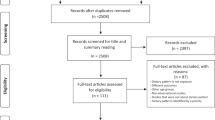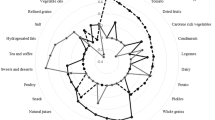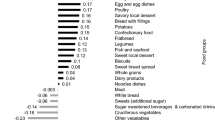Abstract
Background/Objectives:
Youth with type 1 diabetes (T1DM) are at substantially increased risk for adverse vascular outcomes, but little is known about the influence of dietary behavior on cardiovascular disease (CVD) risk profile. We aimed to identify dietary intake patterns associated with CVD risk factors and evaluate their impact on arterial stiffness (AS) measures collected thereafter in a cohort of youth with T1DM.
Subjects/Methods:
Baseline diet data from a food frequency questionnaire and CVD risk factors (triglycerides, low density lipoprotein-cholesterol, systolic blood pressure, hemoglobin A1c, C-reactive protein and waist circumference) were available for 1153 youth aged ⩾10 years with T1DM from the SEARCH for Diabetes in Youth Study. A dietary intake pattern was identified using 33 food groups as predictors and six CVD risk factors as responses in reduced rank regression (RRR) analysis. Associations of this RRR-derived dietary pattern with AS measures (augmentation index (AIx75), n=229; pulse wave velocity, n=237; and brachial distensibility, n=228) were then assessed using linear regression.
Results:
The RRR-derived pattern was characterized by high intakes of sugar-sweetened beverages (SSB) and diet soda, eggs, potatoes and high-fat meats and low intakes of sweets/desserts and low-fat dairy; major contributors were SSB and diet soda. This pattern captured the largest variability in adverse CVD risk profile and was subsequently associated with AIx75 (β=0.47; P<0.01). The mean difference in AIx75 concentration between the highest and the lowest dietary pattern quartiles was 4.3% in fully adjusted model.
Conclusions:
Intervention strategies to reduce consumption of unhealthy foods and beverages among youth with T1DM may significantly improve CVD risk profile and ultimately reduce the risk for AS.
This is a preview of subscription content, access via your institution
Access options
Subscribe to this journal
Receive 12 print issues and online access
$259.00 per year
only $21.58 per issue
Buy this article
- Purchase on Springer Link
- Instant access to full article PDF
Prices may be subject to local taxes which are calculated during checkout

Similar content being viewed by others
References
Dabelea D, Bell RA, D'Agostino RB Jr, Imperatore G, Johansen JM, Linder B et al. Incidence of diabetes in youth in the United States. JAMA 2007; 297: 2716–2724.
Snell-Bergeon JK, Hokanson JE, Jensen L, MacKenzie T, Kinney G, Dabelea D et al. Progression of coronary artery calcification in type 1 diabetes: the importance of glycemic control. Diabetes Care 2003; 26: 2923–2928.
Orchard TJ, Olson JC, Erbey JR, Williams K, Forrest KY, Smithline KL et al. Insulin resistance-related factors, but not glycemia, predict coronary artery disease in type 1 diabetes: 10-year follow-up data from the Pittsburgh Epidemiology of Diabetes Complications Study. Diabetes Care 2003; 26: 1374–1379.
Soedamah-Muthu SS, Chaturvedi N, Toeller M, Ferriss B, Reboldi P, Michel G et al. Risk factors for coronary heart disease in type 1 diabetic patients in Europe: the EURODIAB Prospective Complications Study. Diabetes Care 2004; 27: 530–537.
Xu Y, Whitmer K C-reactive protein and cardiovascular disease in people with diabetes: high-sensitivity CRP testing can help assess risk for future cardiovascular disease events in this population. Am J Nurs 2006; 106: 66–72.
Wadwa RP, Urbina EM, Anderson AM, Hamman RF, Dolan LM, Rodriguez BL et al. Measures of arterial stiffness in youth with type 1 and type 2 diabetes: the SEARCH for diabetes in youth study. Diabetes Care 2010; 33: 881–886.
Grauslund J, Jorgensen TM, Nybo M, Green A, Rasmussen LM, Sjolie AK Risk factors for mortality and ischemic heart disease in patients with long-term type 1 diabetes. J Diabetes Complications 2010; 24: 223–228.
Raitakari OT, Juonala M, Kahonen M, Taittonen L, Laitinen T, Maki-Torkko N et al. Cardiovascular risk factors in childhood and carotid artery intima-media thickness in adulthood: the Cardiovascular Risk in Young Finns Study. JAMA 2003; 290: 2277–2283.
Kershnar AK, Daniels SR, Imperatore G, Palla SL, Petitti DB, Pettitt DJ et al. Lipid abnormalities are prevalent in youth with type 1 and type 2 diabetes: the SEARCH for Diabetes in Youth Study. J Pediatr 2006; 149: 314–319.
Petitti DB, Klingensmith GJ, Bell RA, Andrews JS, Dabelea D, Imperatore G et al. Glycemic control in youth with diabetes: the SEARCH for diabetes in Youth Study. J Pediatr 2009; 155: 668–672.
Urbina EM, Wadwa RP, Davis C, Snively BM, Dolan LM, Daniels SR et al. Prevalence of increased arterial stiffness in children with type 1 diabetes mellitus differs by measurement site and sex: the SEARCH for Diabetes in Youth Study. J Pediatr 2010; 156: 731–737.
Gunther AL, Liese AD, Bell RA, Dabelea D, Lawrence JM, Rodriguez BL et al. Association between the dietary approaches to hypertension diet and hypertension in youth with diabetes mellitus. Hypertension 2009; 53: 6–12.
Liese AD, Bortsov A, Gunther AL, Dabelea D, Reynolds K, Standiford DA et al. Association of DASH diet with cardiovascular risk factors in youth with diabetes mellitus: the SEARCH for Diabetes in Youth study. Circulation 2011; 123: 1410–1417.
Wiltshire EJ, Hirte C, Couper JJ Dietary fats do not contribute to hyperlipidemia in children and adolescents with type 1 diabetes. Diabetes Care 2003; 26: 1356–1361.
Hoffmann K, Zyriax BC, Boeing H, Windler E A dietary pattern derived to explain biomarker variation is strongly associated with the risk of coronary artery disease. Am J Clin Nutr 2004; 80: 633–640.
Nettleton JA, Steffen LM, Schulze MB, Jenny NS, Barr RG, Bertoni AG et al. Associations between markers of subclinical atherosclerosis and dietary patterns derived by principal components analysis and reduced rank regression in the Multi-Ethnic Study of Atherosclerosis (MESA). Am J Clin Nutr 2007; 85: 1615–1625.
Liese AD, Weis KE, Schulz M, Tooze JA Food intake patterns associated with incident type 2 diabetes: the Insulin Resistance Atherosclerosis Study. Diabetes Care 2009; 32: 263–268.
SEARCH Study Group. SEARCH for Diabetes in Youth: a multicenter study of the prevalence, incidence and classification of diabetes mellitus in youth. Control Clin Trials 2004; 25: 458–471.
Mayer-Davis EJ, Nichols M, Liese AD, Bell RA, Dabelea DM, Johansen JM et al. Dietary intake among youth with diabetes: the SEARCH for Diabetes in Youth Study. J Am Diet Assoc 2006; 106: 689–697.
Centers for Disease Control and Prevention. The Third National Health and Nutrition Examination Survey (NHANES III 1988–94) Reference Manuals and Reports. National Center for Health Statistics: Bethesda, MD, USA, 2005.
Kuczmarski RJ, Ogden CL, Guo SS, Grummer-Strawn LM, Flegal KM, Mei Z et al. 2000 CDC Growth Charts for the United States: methods and development. Vital Health Stat 11 2002; 246: 1–190.
Mayer-Davis EJ, Ma B, Lawson A, D'Agostino RB Jr, Liese AD, Bell RA et al. Cardiovascular disease risk factors in youth with type 1 and type 2 diabetes: implications of a factor analysis of clustering. Metab Syndr Relat Disord 2009; 7: 89–95.
Hoffmann K, Schulze MB, Schienkiewitz A, Nothlings U, Boeing H Application of a new statistical method to derive dietary patterns in nutritional epidemiology. Am J Epidemiol 2004; 159: 935–944.
Willett W, Stampfer MJ Total energy intake: implications for epidemiologic analyses. Am J Epidemiol 1986; 124: 17–27.
Retnakaran R, Zinman B, Connelly PW, Harris SB, Hanley AJ Nontraditional cardiovascular risk factors in pediatric metabolic syndrome. J Pediatr 2006; 148: 176–182.
Schulze MB, Hoffmann K, Kroke A, Boeing H An approach to construct simplified measures of dietary patterns from exploratory factor analysis. Br J Nutr 2003; 89: 409–419.
Kesse-Guyot E, Vergnaud AC, Fezeu L, Zureik M, Blacher J, Peneau S et al. Associations between dietary patterns and arterial stiffness, carotid artery intima-media thickness and atherosclerosis. Eur J Cardiovasc Prev Rehabil 2010; 17: 718–724.
van de Laar RJ, Stehouwer CD, van Bussel BC, Prins MH, Twisk JW, Ferreira I Adherence to a Mediterranean dietary pattern in early life is associated with lower arterial stiffness in adulthood: the Amsterdam Growth and Health Longitudinal Study. J Intern Med 2013; 273: 79–93.
Lutsey PL, Steffen LM, Stevens J Dietary intake and the development of the metabolic syndrome: the Atherosclerosis Risk in Communities Study. Circulation 2008; 117: 754–761.
Giammattei J, Blix G, Marshak HH, Wollitzer AO, Pettitt DJ Television watching and soft drink consumption: associations with obesity in 11- to 13-year-old schoolchildren. Arch Pediatr Adolesc Med 2003; 157: 882–886.
Malik VS, Popkin BM, Bray GA, Despres JP, Willett WC, Hu FB Sugar-sweetened beverages and risk of metabolic syndrome and type 2 diabetes: a meta-analysis. Diabetes Care 2010; 33: 2477–2483.
Nettleton JA, Lutsey PL, Wang Y, Lima JA, Michos ED, Jacobs DR Jr Diet soda intake and risk of incident metabolic syndrome and type 2 diabetes in the Multi-Ethnic Study of Atherosclerosis (MESA). Diabetes Care 2009; 32: 688–694.
Bortsov AV, Liese AD, Bell RA, Dabelea D, D'Agostino RB Jr, Hamman RF et al. Sugar-sweetened and diet beverage consumption is associated with cardiovascular risk factor profile in youth with type 1 diabetes. Acta Diabetol 2011; 48: 275–282.
Djousse L, Gaziano JM Egg consumption in relation to cardiovascular disease and mortality: the Physicians' Health Study. Am J Clin Nutr 2008; 87: 964–969.
Rong Y, Chen L, Zhu T, Song Y, Yu M, Shan Z et al. Egg consumption and risk of coronary heart disease and stroke: dose-response meta-analysis of prospective cohort studies. BMJ 2013; 346: e8539.
Pan A, Sun Q, Bernstein AM, Manson JE, Willett WC, Hu FB Changes in red meat consumption and subsequent risk of type 2 diabetes mellitus: three cohorts of US men and women. JAMA Intern Med 2013; 173: 1328–1335.
Kumar S, Dutt A, D'Souza N, Bhat S, Hemraj S A study of meat consumption on cardio-metabolic risk factors in pre-menopausal type-2 diabetes patients. Natl J Physiol Pharm Pharmacol 2011; 1: 57–62.
Halton TL, Willett WC, Liu S, Manson JE, Stampfer MJ, Hu FB Potato and french fry consumption and risk of type 2 diabetes in women. Am J Clin Nutr 2006; 83: 284–290.
Givens DI Milk in the diet: good or bad for vascular disease? Proc Nutr Soc 2012; 71: 98–104.
Kris-Etherton PM, Grieger JA, Hilpert KF, West SG Milk products, dietary patterns and blood pressure management. J Am Coll Nutr 2009; 28 (Suppl 1): 103S–119S.
Howard BV, Wylie-Rosett J Sugar and cardiovascular disease: a statement for healthcare professional from the committee on nutrition of the council on nutrition, physical activity, and metabolism of the american heart association. Circulation 2002; 106: 523–527.
McEniery CM, Wallace S, Mackenzie IS, McDonnell B, Yasmin, Newby DE et al. Endothelial function is associated with pulse pressure, pulse wave velocity, and augmentation index in healthy humans. Hypertension 2006; 48: 602–608.
Laurent S, Cockcroft J, Van BL, Boutouyrie P, Giannattasio C, Hayoz D et al. Expert consensus document on arterial stiffness: methodological issues and clinical applications. Eur Heart J 2006; 27: 2588–2605.
Vlachopoulos C, Aznaouridis K, Stefanadis C Prediction of cardiovascular events and all-cause mortality with arterial stiffness: a systematic review and meta-analysis. J Am Coll Cardiol 2010; 55: 1318–1327.
Wadwa RP, Urbina EM, Talton J, D'Agostino R, Jaiswal M, Shah AS et al. Arterial stiffness in youth with and without type 1 diabetes: the SEARCH CVD Study. Diabetes 2011; 60 (Suppl 1): A140 (Poster).
Acknowledgements
The SEARCH Nutrition Ancillary Study and the SEARCH for Diabetes in Youth Study are indebted to the many youth and their families and their health-care providers, whose participation made this study possible. The SEARCH Nutrition Ancillary Study (R01 DK 077949, PI Mayer-Davis) is funded by the NIDDK. SEARCH for Diabetes in Youth is funded by the Centers for Disease Control and Prevention (PA numbers 00097, DP-05-069, and DP-10-001) and supported by the National Institute of Diabetes and Digestive and Kidney Diseases (NIDDK). The SEARCH AIR Ancillary study (R01 ES 019168, PI Puett) is funded by the National Institute of Environmental Health Sciences. The SEARCH CVD study (R01DK078542, PI Dabelea) is funded by NIDDK.
Author information
Authors and Affiliations
Corresponding author
Ethics declarations
Competing interests
The authors declare no conflict of interest.
Additional information
Supplementary Information accompanies this paper on European Journal of Clinical Nutrition website
Supplementary information
Rights and permissions
About this article
Cite this article
Lamichhane, A., Liese, A., Urbina, E. et al. Associations of dietary intake patterns identified using reduced rank regression with markers of arterial stiffness among youth with type 1 diabetes. Eur J Clin Nutr 68, 1327–1333 (2014). https://doi.org/10.1038/ejcn.2014.96
Received:
Revised:
Accepted:
Published:
Issue Date:
DOI: https://doi.org/10.1038/ejcn.2014.96



